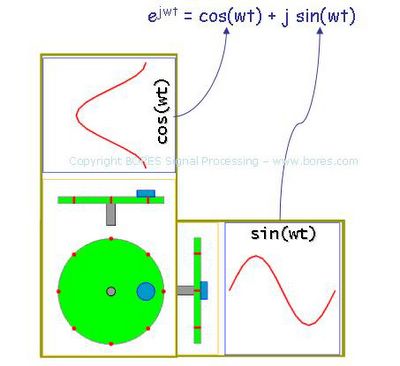Geometric signal interpretation of complex exponential oscillators

Following from my last post on geometric interpretation of complex numbers, I looked for a clear explanation of complex exponentials.
The model of complex exponentials:
a = a ejA = a cos(A) + j * a sin(A)
lets us use complex arithmetic to do things with vectors.
To see how this can be used to model real signals, think about a rotating wheel with a knob on. I found a nice animation of this by Jim Lesurf of the University of Saint Andrews which has a nice beach (though very cold) and a famous golf course nearby. His animation is at:
http://www.st-andrews.ac.uk/~www_pa/Scots_Guide/info/signals/complex/cmplx.html
and I borrowed his pictures (with permission) to use in the slide I generated (an extract from which is shown above).
If we look at the wheel from the front, we can see that the motion of the knob is circular. But if we look from the side, it looks as though the knob just goes up and down - and if we plotted its up- and down-ness against time this would be a sine wave.
Think for a moment, and realize that we cannot tell from the side whether the wheel is rotating clockwise or counter-clockwise - so we have lost some information by only looking from one side (and this must be a Bad Thing). Also, sometimes we measure only small displacements of the knob in the up and down sense - and if there were also noise signals then sometimes the signal may be buried in the noise - so we can infer that we have lost some signal-to-noise ratio too.
We can recapture all the information by realizing the signal is 2D and so we can fully represent it by a 2D vector, drawn from the center of the wheel to the knob - and this vector can of course be represented by a complex number. Now we will see two sine-like waves - a sine wave from one side, and a cosine from the other - and can plot the circular path.
Suppose the vector is a, and the angle of the wheel at time t is (wt), then the knob’s position at time t can be represented by the vector:
a ejA = a cos(A) + j * a sin(A)
If the wheel were replaced by some kind of eccentric crank, or by a complex system of gears, we would still be able to fully reconstruct the path but of course the component signals would not be simple pure sine and cosine waves.
Taking it further, imagine a rotating bar magnet with two coils at right angles: the magnetic fluc willcross the coilds and generate sine and cosine currents in each. Of course the bar magnet could be the magnetic vector of a radio photon, in which case we have a nice model of quadrature RF detection coils.
So complex exponentials give us a nice way to model oscillators.
Comments
Post a Comment